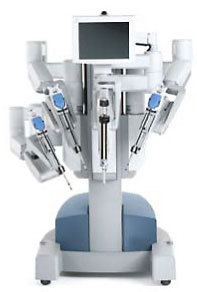Gynecologic Surgery: Joycelyn's Story
The da Vinci System Comes to Holy Cross Hospital
Robotic surgery doesn't mean robots are scrubbing up and operating on patients. Human physicians are still in charge. But they are using robots as tools.
"Holy Cross Hospital is the first hospital in Montgomery County to have the da Vinci® robot," says Albert J. Steren, MD, medical director, Gynecologic Oncology, Holy Cross Hospital. "As science and medicine make life-altering advances, Holy Cross Hospital is committed to making these incredible treatment options available to patients." And, patients are reaping the benefits from the new da Vinci surgical robot.
When comparing a previous surgery to remove fibroids to her robotic surgery this past May to remove her cancerous cervix and to sample lymph nodes, Joycelyn Jones says: "Robotic surgery was good because the recovery was far better. It was less painful, I healed faster, and I could move around much sooner."
Less-Invasive Surgery
Maybe you've heard about surgeries that are minimally invasive. This means surgeons keep incisions small by using the latest tools and techniques. As a result, these surgeries are less traumatic to the body. People who have them tend to heal more quickly, spend less time in the hospital and go home faster.
And with robots in the operating room, these techniques are even more effective.
Meet The Robots
Millions of surgeries each year use a minimally invasive technique called laparoscopy. Instead of making large cuts to expose the area being treated, the surgeon makes small incisions, through which he or she inserts long, narrow surgical instruments and a tiny video camera into the body. The camera shows an image of the surgical site on a video screen, which the surgeon monitors while performing the procedure.
each year use a minimally invasive technique called laparoscopy. Instead of making large cuts to expose the area being treated, the surgeon makes small incisions, through which he or she inserts long, narrow surgical instruments and a tiny video camera into the body. The camera shows an image of the surgical site on a video screen, which the surgeon monitors while performing the procedure.
Robotic surgery uses small instruments and a camera in much the same way. But instead of the surgeon holding the instruments, robot arms hold them. The robot uses the instruments to cut and suture (sew) just as a human surgeon would but with greater precision.
Using the da Vinci system, the surgeon remains in complete control of the procedure without ever touching the patient's body. The robot seamlessly replicates the surgeon's hand, wrist and finger movements into precise real-time movements of surgical instruments inside the patient.
"This system allows for more precision and more accuracy and consistently results in better patient outcomes," says James F. Barter, MD, medical coordinator, Gynecologic Oncology Research, Holy Cross Hospital, who also performs gynecologic surgery using the da Vinci robot.
At the heart of the success of the da Vinci system are two high-resolution fiberoptic cameras that produce a true, 3-D, color picture to help surgeons better view the surgical area, which is critical when performing delicate procedures.
Moving Forward
The da Vinci Surgical System builds on the advances made by laparoscopic surgery over open surgery, taking the concept beyond the limits of the human hand. "This is revolutionary," Dr. Steren says. "We are on the precipice of a whole new way of doing surgery. Using da Vinci, we can undertake even more radical procedures in a way that creates much less tissue trauma, and patients can often be out of the hospital the very same day."
Holy Cross Hospital surgeons perform more gynecologic and gynecologic oncology surgeries than any other hospital in Maryland or the District of Columbia. Holy Cross Hospital's current plans are to expand use of the da Vinci system to urologic, cardiothoracic and general surgeries in the near future.
This article appeared in the Fall 2008 edition of Holy Cross Health.
